一,ansible是一种由Python开发的自动化运维工具,集合了众多运维工具(puppet、cfengine、chef、func、fabric)的优点,实现了批量系统配置、批量程序部署、批量运行命令等功能
二,特点
* 部署简单
* **默认使用ssh进行管理,基于python里的==paramiko==模块开发**
* 管理端和被管理端不需要启动服务
* 配置简单,功能强大,扩展性强
* 能过playbook(剧本)进行多个任务的编排
三,ansible搭建
实验准备三台机器,一台管理机 192.168.115.3,两台被管理机 192.168.115.4 192.168.115.5
#所有主机都要配置主机名和 hosts文件
[root@hd1 ~]# hostnamectl set-hostname hd1
[root@hd1 ~]# cat /etc/hosts
127.0.0.1 localhost localhost.localdomain localhost4 localhost4.localdomain4
::1 localhost localhost.localdomain localhost6 localhost6.localdomain6
192.168.1.11 hd1
192.168.1.12 hd2
192.168.1.13 hd3

#hd2和hd3 同上类似操作
关闭防火墙, selinux


时间同步
下载更新epel源
yum -y install epel-release

管理机上安装ansible,被管理节点必须打开ssh服务
yum install epel-release
yum install ansible
查看版本ansible --version

实现master对agent的免密登录,只在master上做。(如果这一步不做,则在后面操作agent时都要加-k参数传密码;或者在主机清单里传密码
ssh-keygen

ssh-copy-id 192.168.115.4 192.168.115.5


在master上定义主机组,并测试连接性
vim /etc/ansible/hosts

ansible -m ping group1
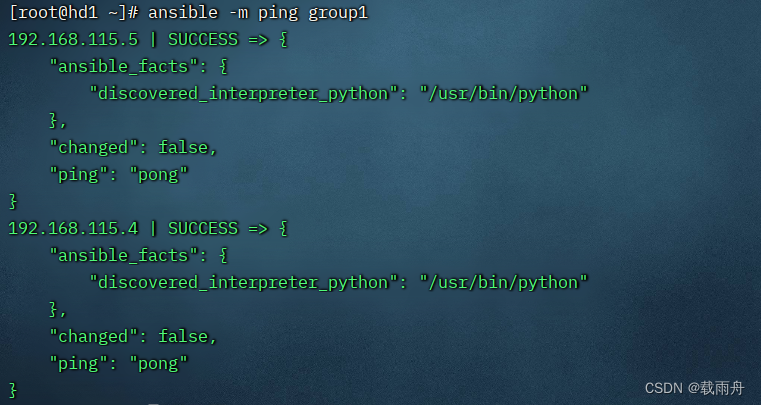
查看支持的模块
ansible-doc -l
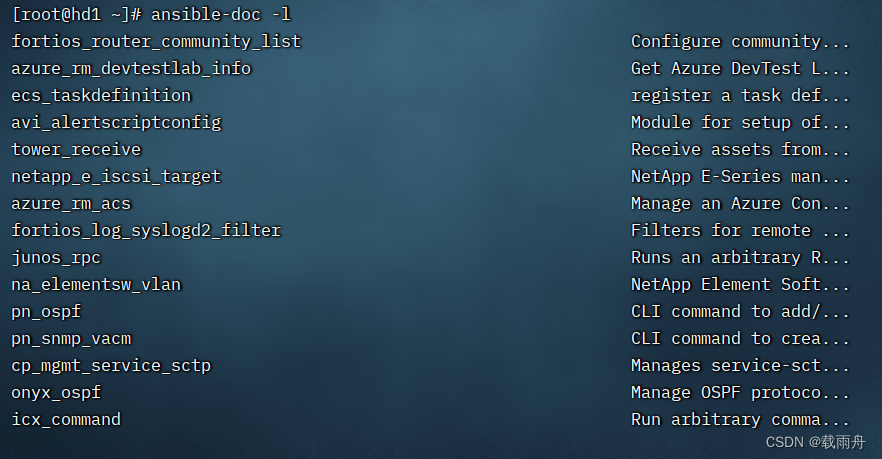
hostname模块配置
hostname模块用于修改主机名(注意: 它不能修改/etc/hosts文件)
将其中一远程机器主机名修改为agent1
ansible 192.168.115.4 -m hostname -a 'name=agent1'
基本格式为: ansible 操作的机器名或组名 -m 模块名 -a "参数1=值1 参数2=值2" argment


测试完改回hd2
file模块
file模块用于对文件相关的操作(创建, 删除, 软硬链接等)
创建一个目录
ansible group1 -m file -a 'path=/test state=directory'


创建一个文件
ansible group1 -m file -a 'path=/test/111 state=touch'


递归修改owner,group,mode
ansible group1 -m file -a 'path=/test recurse=yes owner=bin group=daemon mode=1777'


测试完改回777权限

删除目录 absent 缺席的(连同目录里的所有文件)
ansible group1 -m file -a 'path=/test state=absent'


创建文件并指定owner,group,mode等
ansible group1 -m file -a 'path=/tmp/111 state=touch owner=bin group=daemon mode=777'

删除文件
ansible group1 -m file -a 'path=/tmp/111 state=absent'


创建软链接文件
ansible group1 -m file -a 'src=/etc/fstab path=/tmp/fstab state=link'
创建硬链接文件
ansible group1 -m file -a 'src=/etc/fstab path=/tmp/fstab2 state=hard'
copy模块
copy模块用于对文件的远程拷贝操作(如把本地的文件拷贝到远程的机器上)
在master上准备一个文件,拷贝此文件到group1的所有机器上
echo master > /tmp/222 ansible group1 -m copy -a 'src=/tmp/222 dest=/tmp/333'


使用content参数直接往远程文件里写内容(会覆盖原内容)
ansible group1 -m copy -a 'content="ha ha\n" dest=/tmp/333'注意:ansible中-a后面的参数里也有引号时,记得要单引双引交叉使用,如果都为双引会出现问题
使用force参数控制是否强制覆盖
先在hd2 hd3里创建文件 touch /tmp/444

如果目标文件已经存在,则不覆盖 ansible group1 -m copy -a 'src=/tmp/222 dest=/tmp/444 force=no'如果目标文件已经存在,则会强制覆盖 ansible group1 -m copy -a 'src=/tmp/222 dest=/tmp/444 force=yes'
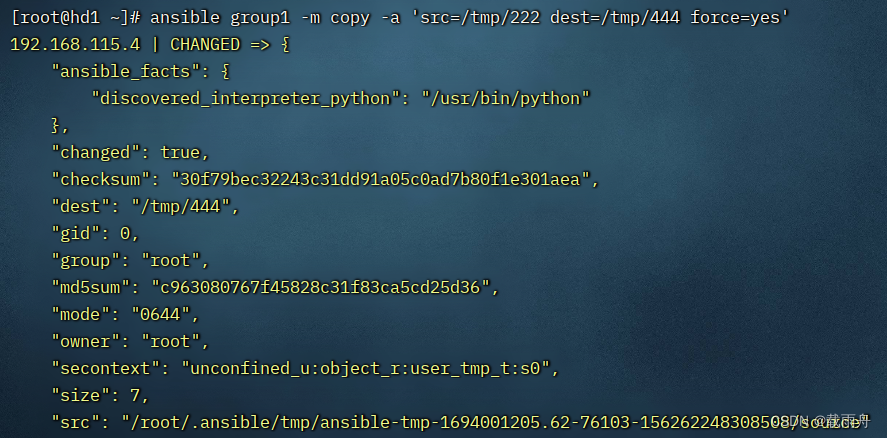

使用backup参数控制是否备份文件
backup=yes表示如果拷贝的文件内容与原内容不一样,则会备份一份 group1的机器上会将/tmp/333备份一份(备份文件命名加上时间),再远程拷贝新的文件为/tmp/333 ansible group1 -m copy -a 'src=/etc/fstab dest=/tmp/333 backup=yes owner=daemon group=daemon mode=777'
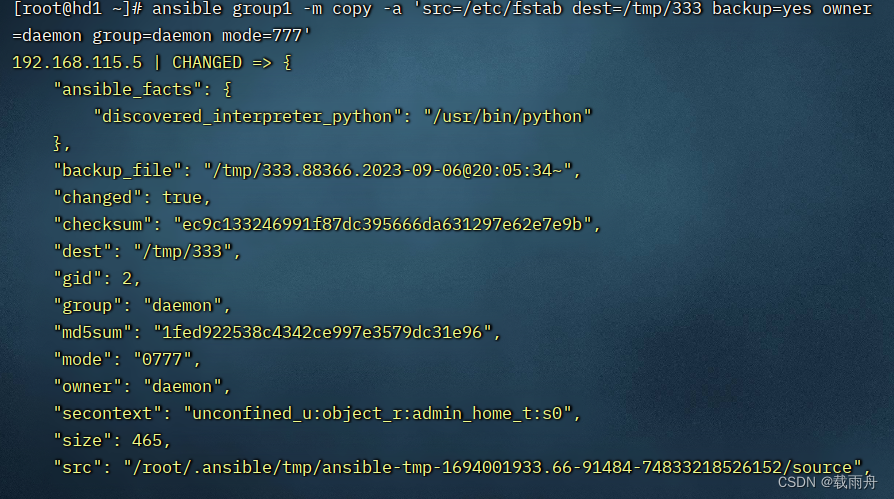


copy模块拷贝时要注意拷贝目录后面是否带"/"符号
/etc/yum.repos.d后面不带/符号,则表示把/etc/yum.repos.d整个目录拷贝到/tmp/目录下 ansible group1 -m copy -a 'src=/etc/yum.repos.d dest=/tmp/'/etc/yum.repos.d/后面带/符号,则表示把/etc/yum.repos.d/目录里的所有文件拷贝到/tmp/目录下 ansible group1 -m copy -a 'src=/etc/yum.repos.d/ dest=/tmp/'


练习: 在master上配置好所有的yum源,然后拷贝到group1的远程机器上(要求目录内的内容完全一致)
master上配置yum源
ansible group1 -m file -a "path=/etc/yum.repos.d/ state=absent" 删除hd2 hd3上的/etc/yum.repos.d目录ansible group1 -m copy -a "src=/etc/yum.repos.d dest=/etc/" 把hd1上的目录拷贝到hd2 hd3

hd2 hd3查看
练习: 使用hostname模块修改过主机名后.在master上修改/etc/hosts文件,并拷贝到group1的远程机器上
先删除hd2 hd3的hosts文件,在master上修改好/etc/hosts文件,然后使用下面命令拷贝过去覆盖 ansible group1 -m copy -a "src=/etc/hosts dest=/etc/hosts"

客户端查看

user模块
user模块用于管理用户账号和用户属性。
创建aaa用户,默认为普通用户,创建家目录
ansible group1 -m user -a ‘name=aaa state=present’


创建bbb系统用户,并且登录shell环境为/sbin/nologin
ansible group1 -m user -a ‘name=bbb state=present system=yes shell="/sbin/nologin"’

创建ccc用户, 使用uid参数指定uid, 使用password参数传密码
echo 123456 | openssl passwd -1 -stdin $1$1a.g59z9$kfIxvDIvOq0g20Sd2XMib0 下一句命令注意一下格式,密码要用双引号引起来,单引号的话验证时会密码不正确 ansible group1 -m user -a 'name=ccc uid=2000 state=present password="$1$1a.g59z9$kfIxvDIvOq0g20Sd2XMib0"'


创建一个普通用户叫hadoop,并产生空密码 密钥对
ansible group1 -m user -a 'name=hadoop generate_ssh_key=yes'

删除aaa用户,但家目录默认没有删除
ansible group1 -m user -a 'name=aaa state=absent'


删除bbb用户,使用remove=yes参数让其删除用户的同时也删除家目录
ansible group1 -m user -a 'name=bbb state=absent remove=yes'


group模块
group模块用于管理用户组和用户组属性。
创建组
ansible group1 -m group -a 'name=groupa gid=3000 state=present'

删除组(如果有用户的gid为此组,则删除不了)
ansible group1 -m group -a 'name=groupa state=absent'
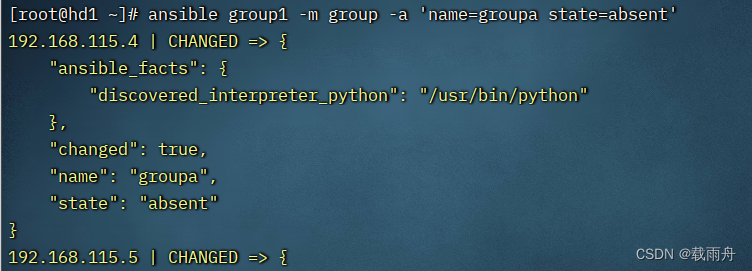
cron模块
cron模块用于管理周期性时间任务
创建一个cron任务,不指定user的话,默认就是root(因为我这里是用root操作的)。 如果minute,hour,day,month,week不指定的话,默认都为*
ansible group1 -m cron -a 'name="test cron1" user=root job="touch /tmp/111" minute=*/2'


删除cron任务
ansible group1 -m cron -a 'name="test cron1" state=absent'
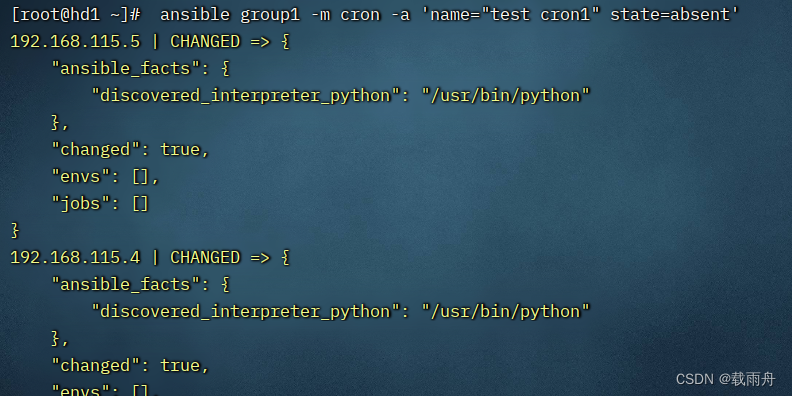
yum_repository模块
yum_repository模块用于配置yum仓库。
增加一个/etc/yum.repos.d/local.repo配置文件
ansible group1 -m yum_repository -a "name=local description=localyum baseurl=file:///mnt/ enabled=yes gpgcheck=no"


注意:此模块只帮助配置yum仓库,但如果仓库里没有软件包,安装一样会失败。所以可以手动去挂载光驱到/mnt目录 # mount /dev/cdrom /mnt
删除/etc/yum.repos.d/local.repo配置文件
ansible group1 -m yum_repository -a "name=local state=absent"


yum模块(重点)
yum模块用于使用yum命令来实现软件包的安装与卸载。
使用yum安装一个软件(前提:group1的机器上的yum配置都已经OK)
ansible group1 -m yum -a 'name=vsftpd state=present'
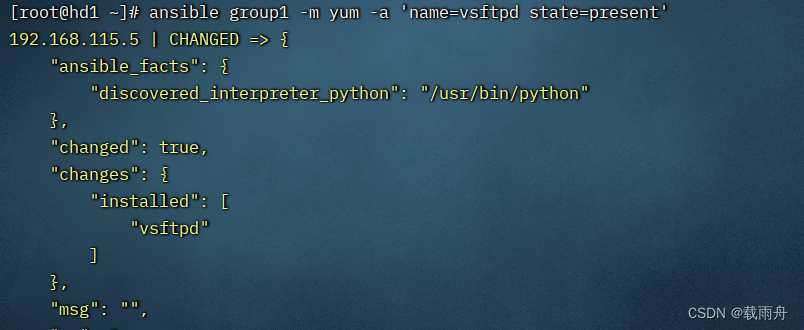

使用yum安装httpd,httpd-devel软件,state=latest表示安装最新版本
ansible group1 -m yum -a 'name=httpd,httpd-devel state=latest'


使用yum卸载httpd,httpd-devel软件
ansible group1 -m yum -a 'name=httpd,httpd-devel state=absent'
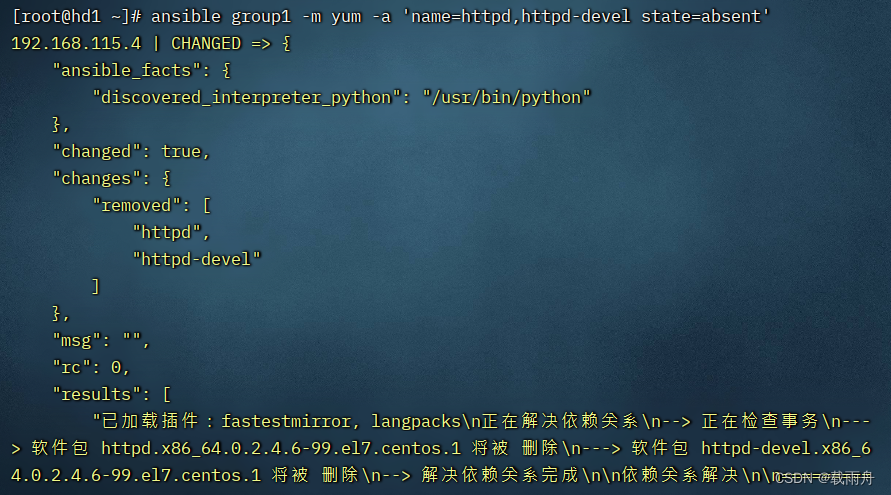
service模块(重点)
service模块用于控制服务的启动,关闭,开机自启动等。
启动vsftpd服务,并设为开机自动启动
ansible group1 -m service -a 'name=vsftpd state=started enabled=on'
关闭vsftpd服务,并设为开机不自动启动
ansible group1 -m service -a 'name=vsftpd state=stopped enabled=false'
练习: 在group1的被管理机里的mariadb里创建一个abc库
mysql -e user=root password=123456 "create database abc ;"
练习:
假设我主机清单里定义的group1里有多台机器,它们现在要做一个集群。此集群要求实现一个名为hadoop的普通用户之间的两两免密登录,如何实现(要求只在master上进行操作)?
script模块
script模块用于在远程机器上执行本地脚本。
在master上准备一个脚本
master# vim /tmp/1.sh
#!/bin/bash
mkdir /tmp/haha
touch /tmp/haha/{1..10}
在group1的远程机器里都执行master上的/tmp/1.sh脚本(此脚本不用给执行权限)
ansible group1 -m script -a '/tmp/1.sh'
扩展: 使用shell脚本实现在group1的被管理机里的mariadb里创建一个abc库
#!/bin/bash yum install mariadb-server -y &> /dev/null systemctl start mariadb systemctl enable mariadb mysql << EOF create database abc; quit EOF 把上面的脚本使用script模块在group1被管理机里执行即可
command与shell模块
两个模块都是用于执行linux命令的,这对于命令熟悉的工程师来说,用起来非常high。
shell模块与command模块差不多(command模块不能执行一些类似$HOME,>,<,|等符号,但shell可以)
ansible.builtin.command module – Execute commands on targets — Ansible Documentation
ansible.builtin.shell module – Execute shell commands on targets — Ansible Documentation
master# ansible -m command group1 -a "useradd user2" master# ansible -m command group1 -a "id user2" master# ansible -m command group1 -a "cat /etc/passwd |wc -l" --报错 master# ansible -m shell group1 -a "cat /etc/passwd |wc -l" --成功 master# ansible -m command group1 -a "cd $HOME;pwd" --报错 master# ansible -m shell group1 -a "cd $HOME;pwd" --成功
注意: shell模块并不是百分之百任何命令都可以,比如vim或ll别名就不可以。不建议大家去记忆哪些命令不可以,大家只要养成任何在生产环境里的命令都要先在测试环境里测试一下的习惯就好。
三、playbook
playbook(剧本): 是ansible用于配置,部署,和管理被控节点的剧本。用于ansible操作的编排。
参考:Ansible playbooks — Ansible Documentation
使用的格式为yaml格式(saltstack,elk,docker,docker-compose,kubernetes等也都会用到yaml格式)
YMAL格式
-
以.yaml或.yml结尾
-
文件的第一行以 "---"开始,表明YMAL文件的开始(可选的)
-
以#号开头为注释
-
列表中的所有成员都开始于相同的缩进级别, 并且使用一个
"- "作为开头(一个横杠和一个空格) -
一个字典是由一个简单的
键: 值的形式组成(这个冒号后面必须是一个空格) -
==注意: 写这种文件不要使用tab键,都使用空格==
参考: YAML Syntax — Ansible Documentation
下面看一个官方的示例感受一下
--- # 一位职工记录 name: Example Developer job: Developer skill: Elite employed: True foods:- Apple- Orange- Strawberry- Mango languages:ruby: Elitepython: Elitedotnet: Lame
playbook实例
先直接来看一个实例
第1步: 创建一个存放playbook的目录(路径自定义)
master# mkdir /etc/ansible/playbook
第2步: 准备httpd配置文件,并修改成你想要的配置
master# yum install httpd -y 按需要修改你想要的配置(为了测试可以随意改动标记一下) master# vim /etc/httpd/conf/httpd.conf
第3步: 写一个playbook文件(后缀为.yml或.yaml)
# vim /etc/ansible/playbook/example.yaml --- - hosts: group1remote_user: roottasks: - name: ensure apache is at the latest version yum: name=httpd,httpd-devel state=latest- name: write the apache config file copy: src=/etc/httpd/conf/httpd.conf dest=/etc/httpd/conf/httpd.confnotify:- restart apache- name: ensure apache is running (and enable it at boot)service: name=httpd state=started enabled=yeshandlers: - name: restart apacheservice: name=httpd state=restarted
第4步: 执行写好的palybook
-
会显示出执行的过程,并且执行的每一步都有ok,changed,failed等标识
-
执行如果有错误(failed)会回滚,解决问题后,直接再执行这条命令即可,并会把failed改为changed(幂等性)
# ansible-playbook /etc/ansible/playbook/example.yaml
Playbook常见语法
hosts: 用于指定要执行任务的主机,其可以是一个或多个由冒号分隔主机组.
remote_user: 用于指定远程主机上的执行任务的用户.
- hosts: group1 remote_user: root
tasks: 任务列表, 按顺序执行任务.
-
如果一个host执行task失败, 整个tasks都会回滚, 修正playbook 中的错误, 然后重新执行即可.
tasks:- name: ensure apache is at the latest version yum: name=httpd,httpd-devel state=latest- name: write the apache config file copy: src=/etc/httpd/conf/httpd.conf dest=/etc/httpd/conf/httpd.conf
handlers: 类似task,但需要使用notify通知调用。
-
不管有多少个通知者进行了notify,等到play中的所有task执行完成之后,handlers也只会被执行一次.
-
handlers最佳的应用场景是用来重启服务,或者触发系统重启操作.除此以外很少用到了.
notify: - restart apache- name: ensure apache is running (and enable it at boot)service: name=httpd state=started enabled=yeshandlers:- name: restart apacheservice: name=httpd state=restarted
练习: 修改httpd的端口为8080,再执行playbook测试
variables: 变量
-
定义变量可以被多次方便调用
master# vim /etc/ansible/playbook/example2.yaml
---
- hosts: group1remote_user: rootvars:- user: test1tasks:- name: create useruser: name={{user}} state=present
~
master# ansible-playbook /etc/ansible/playbook/example2.yaml
案例: playbook编排vsftpd
写一个playbook实现
-
配置yum
-
安装vsftpd包
-
修改配置文件(要求拒绝匿名用户登录)
-
启动服务并实现vsftpd服务开机自动启动
--- - hosts: group1 remote_user: root tasks: - name: rm yum repository file: path=/etc/yum.repos.d/ state=absent- name: 同步master上的yum源到group1copy: src=/etc/yum.repos.d dest=/etc/- name: ensure vsftpd is at the latest version yum: name=vsftpd state=latest- name: write the apache config file copy: src=/etc/vsftpd/vsftpd.conf dest=/etc/vsftpd/vsftpd.conf notify: - restart vsftpd- name: ensure vsftpd is running (and enable it at boot)service: name=vsftpd state=started enabled=yeshandlers: - name: restart vsftpd service: name=vsftpd state=restarted
playbook编排多个hosts任务
--- # ---代表开始(可选项,不写也可以) - hosts: 10.1.1.12remote_user: roottasks:- name: 创建/test1/目录file: path=/test1/ state=directory # 这里不能用---分隔,会报语法错误(后面课程玩k8s编排也写YAML文件,是可以用---来分隔段落的) - hosts: 10.1.1.13remote_user: roottasks:- name: 创建/test2/目录file: path=/test2/ state=directory ... # ...代表结束(可选项,不写也可以)
案例: 编排nfs搭建与客户端挂载
1, 在master上准备nfs配置文件
# vim /etc/exports /share *(ro)
2, 编写yaml编排文件
# vim /etc/ansible/playbook/nfs.yml --- - hosts: 10.1.1.12remote_user: roottasks:- name: 安装nfs服务相关软件包yum: name=nfs-utils,rpcbind,setup state=latest - name: 创建共享目录file: path=/share/ state=directory - name: 同步nfs配置文件copy: src=/etc/exports dest=/etc/exports notify: restart nfs - name: 启动rpcbind服务,并设置为开机自启动service: name=rpcbind state=started enabled=on - name: 启动nfs服务,并设置为开机自启动service: name=nfs state=started enabled=on handlers:- name: restart nfsservice: name=nfs state=restarted - hosts: 10.1.1.13remote_user: roottasks:- name: 安装nfs客户端软件包yum: name=nfs-utils state=latest - name: 挂载nfs服务器的共享shell: mount 10.1.1.12:/share /mnt
3, 执行playbook
# ansible-playbook /etc/ansible/playbook/nfs.yaml





生成链接过程的.map映射文件以及.map映射文件的内容说明)










拦截器,屏蔽键盘深入解析)


